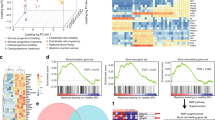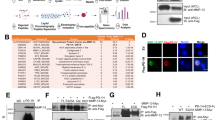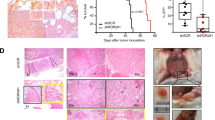Abstract
Previously, bone morphogenetic protein (BMP)-2 and -4 have been shown to inhibit proliferation and induce apoptosis in human myeloma cells. BMP-2 and -4 belong to a subgroup of BMPs using the BMP receptors Alk-3 or -6. In this study, we examined the effects on human myeloma cells of BMP-6 and -7, members of a different BMP subgroup, which mainly utilize Alk-2 as their receptor. All cell lines examined expressed mRNA for the BMP-6 and -7 receptor Alk-2. We did not detect transcripts for the BMP-2 and -4 receptors Alk-3 or Alk-6 in INA-6 and RPMI-8226 cells by RT–PCR. Accordingly, the intracellular signalling molecules Smad-1, -5 and -8 were not phosphorylated by BMP-4 in INA-6 and RPMI-8226 cells. The expression patterns of various BMP receptors in the myeloma cell lines explained the differences in responses to the various BMPs. Alk-2-expressing cell lines responded with growth inhibition and apoptosis to BMP-6 and -7, whereas cell lines lacking both Alk-3 and -6 were resistant to BMP-4. Soluble Alk-3 and -6 were able to neutralize the BMP-4 effects in BMP-4-responsive cell lines. All BMPs reduced viability in more than 70% of purified primary myeloma cell samples. BMPs have intriguing antitumor effects in vitro. Importantly, myeloma cells not responsive to BMP-2 and -4 may still be sensitive to BMP-6 or -7. It is possible that therapeutic use of BMP or BMP analogues could have an impact on both myeloma bone disease and myeloma cell growth.
This is a preview of subscription content, access via your institution
Access options
Subscribe to this journal
Receive 50 print issues and online access
$259.00 per year
only $5.18 per issue
Buy this article
- Purchase on Springer Link
- Instant access to full article PDF
Prices may be subject to local taxes which are calculated during checkout







Similar content being viewed by others
References
Beck HN, Drahushuk K, Jacoby DB, Higgins D and Lein PJ . (2001). BMC Neurosci., 2, 12.
Bhatia M, Bonnet D, Wu D, Murdoch B, Wrana J, Gallacher L and Dick JE . (1999). J. Exp. Med., 189, 1139–1148.
Borset M, Hjorth-Hansen H, Seidel C, Sundan A and Waage A . (1996). Blood, 88, 3998–4004.
Borset M, Waage A, Brekke OL and Helseth E . (1994). Eur. J. Haematol., 53, 31–37.
Brenne AT, Ro TB, Waage A, Sundan A, Borset M and Hjorth-Hansen H . (2002). Blood, 99, 3756–3762.
Chang CF, Lin SZ, Chiang YH, Morales M, Chou J, Lein P, Chen HL, Hoffer BJ and Wang Y . (2003). Stroke, 34, 558–564.
Durie BG and Salmon SE . (1975). Cancer, 36, 842–854.
Ebisawa T, Tada K, Kitajima I, Tojo K, Sampath TK, Kawabata M, Miyazono K and Imamura T . (1999). J. Cell Sci., 112 (Part 20), 3519–3527.
Franzen A and Heldin NE . (2001). Biochem. Biophys. Res. Commun., 285, 773–781.
Friedlaender GE, Perry CR, Cole JD, Cook SD, Cierny G, Muschler GF, Zych GA, Calhoun JH, LaForte AJ and Yin S . (2001). J. Bone Joint Surg. Am., 83-A (Suppl 1), S151–S158.
Gazitt Y . (1999). Leukemia, 13, 1817–1824.
Gilboa L, Nohe A, Geissendorfer T, Sebald W, Henis YI and Knaus P . (2000). Mol. Biol. Cell, 11, 1023–1035.
Hahn SA, Schutte M, Hoque AT, Moskaluk CA, da Costa LT, Rozenblum E, Weinstein CL, Fischer A, Yeo CJ, Hruban RH and Kern SE . (1996). Science, 271, 350–353.
Hallahan AR, Pritchard JI, Chandraratna RAS, Ellenbogen RG, Geyer JR, Overland RP, Strand AD, Tapscott SJ and Olson JM . (2003). Nat. Med., 9, 1033–1038.
Hjertner O, Hjorth-Hansen H, Borset M, Seidel C, Waage A and Sundan A . (2001). Blood, 97, 516–522.
Jackson N, Lowe J, Ball J, Bromidge E, Ling NR, Larkins S, Griffith MJ and Franklin IM . (1989). Clin. Exp. Immunol., 75, 93–99.
Jernberg-Wiklund H, Pettersson M and Nilsson K . (1991). Eur. J. Haematol., 46, 231–239.
Kawamura C, Kizaki M, Yamato K, Uchida H, Fukuchi Y, Hattori Y, Koseki T, Nishihara T and Ikeda Y . (2000). Blood, 96, 2005–2011.
Kim IY, Lee DH, Ahn HJ, Tokunaga H, Song W, Devereaux LM, Jin D, Sampath TK and Morton RA . (2000). Cancer Res., 60, 2840–2844.
Nishihara T, Okahashi N and Ueda N . (1993). Biochem. Biophys. Res. Commun., 197, 985–991.
Nohe A, Hassel S, Ehrlich M, Neubauer F, Sebald W, Henis YI and Knaus P . (2002). J. Biol. Chem., 277, 5330–5338.
Paine-Saunders S, Viviano BL, Economides AN and Saunders S . (2002). J. Biol. Chem., 277, 2089–2096.
Rodriguez-Leon J, Merino R, Macias D, Ganan Y, Santesteban E and Hurle JM . (1999). Nat. Cell Biol., 1, 125–126.
Seidel C, Sundan A, Hjorth M, Turesson I, Dahl IM, Abildgaard N, Waage A and Borset M . (2000). Blood, 95, 388–392.
Shima Y, Nishimoto N, Ogata A, Fujii Y, Yoshizaki K and Kishimoto T . (1995). Blood, 85, 757–764.
Tarte K, Zhan F, De Vos J, Klein B and Shaughnessy J . (2003). Blood, 102, 592–600.
ten Dijke P, Yamashita H, Ichijo H, Franzen P, Laiho M, Miyazono K and Heldin CH . (1994a). Science, 264, 101–104.
ten Dijke P, Yamashita H, Sampath TK, Reddi AH, Estevez M, Riddle DL, Ichijo H, Heldin CH and Miyazono K . (1994b). J. Biol. Chem., 269, 16985–16988.
Tsuchida K, Sawchenko PE, Nishikawa S and Vale WW . (1996). Mol. Cell Neurosci., 7, 467–478.
Urashima M, Ogata A, Chauhan D, Hatziyanni M, Vidriales MB, Dedera DA, Schlossman RL and Anderson KC . (1996). Blood, 87, 1928–1938.
Urist MR . (1965). Science, 150, 893–899.
Wach S, Schirmacher P, Protschka M and Blessing M . (2001). Oncogene, 20, 7761–7769.
Wozney JM . (1989). Prog. Growth Factor Res., 1, 267–280.
Yamashita H, ten Dijke P, Huylebroeck D, Sampath TK, Andries M, Smith JC, Heldin CH and Miyazono K . (1995). J. Cell Biol., 130, 217–226.
Zavadil J, Brezinova J, Svoboda P, Zemanova Z and Michalova K . (1997). Leukemia, 11, 1187–1192.
Zimmerman LB, Jesus-Escobar JM and Harland RM . (1996). Cell, 86, 599–606.
Acknowledgements
We thank Hanne Hella, Berit F Stordal and Siv H Moen for excellent technical assistance. This study was supported by grants from The Norwegian Cancer Society, The Cancer Fund of St Olav's Hospital and The Norwegian Research Council.
Author information
Authors and Affiliations
Corresponding author
Rights and permissions
About this article
Cite this article
Baade Ro, T., Utne Holt, R., Brenne, AT. et al. Bone morphogenetic protein-5, -6 and -7 inhibit growth and induce apoptosis in human myeloma cells. Oncogene 23, 3024–3032 (2004). https://doi.org/10.1038/sj.onc.1207386
Received:
Revised:
Accepted:
Published:
Issue Date:
DOI: https://doi.org/10.1038/sj.onc.1207386



